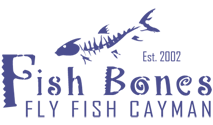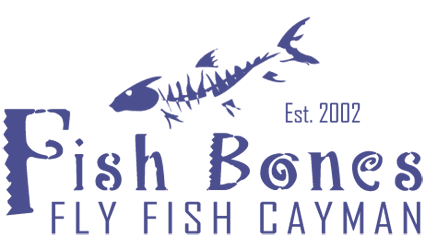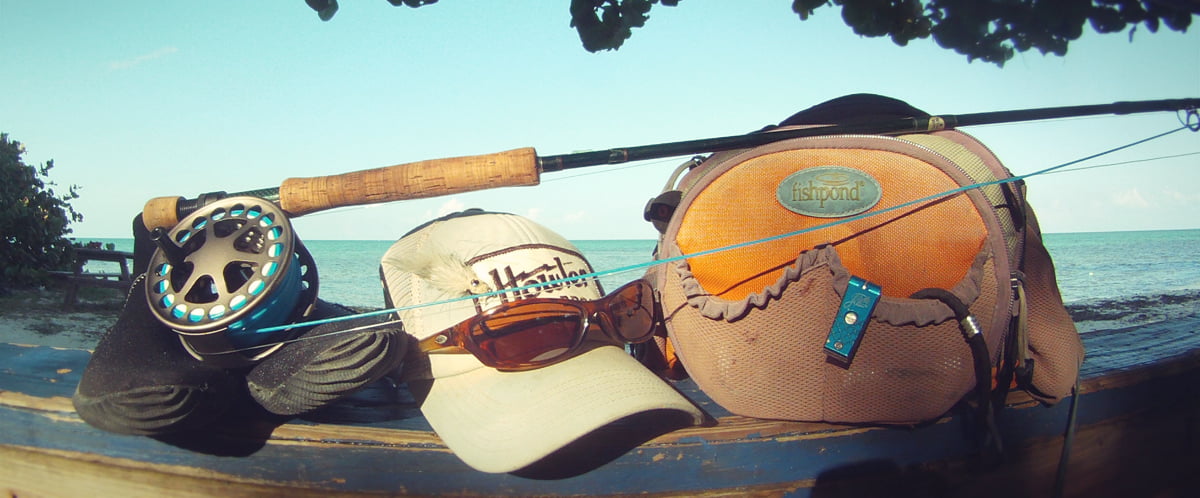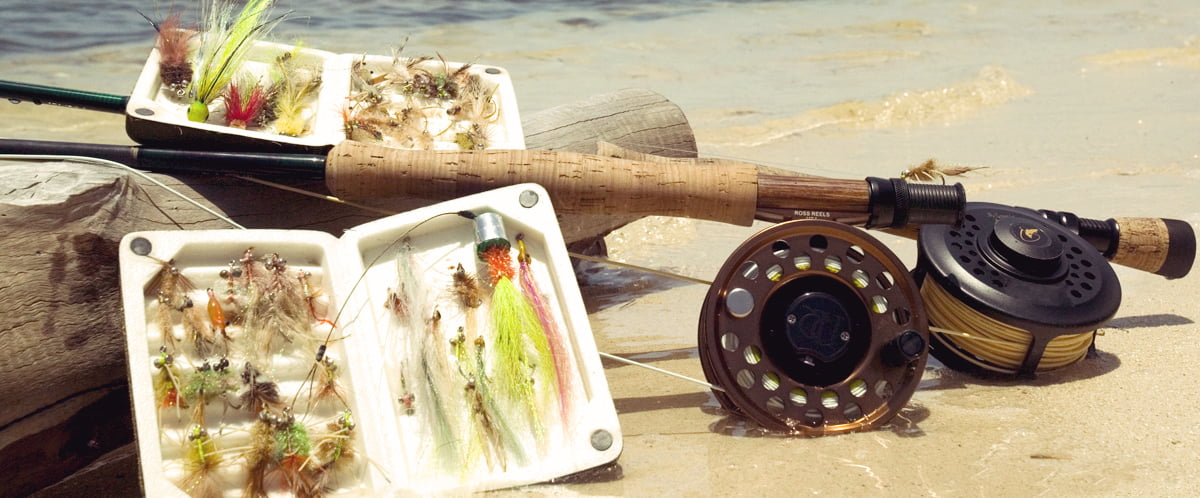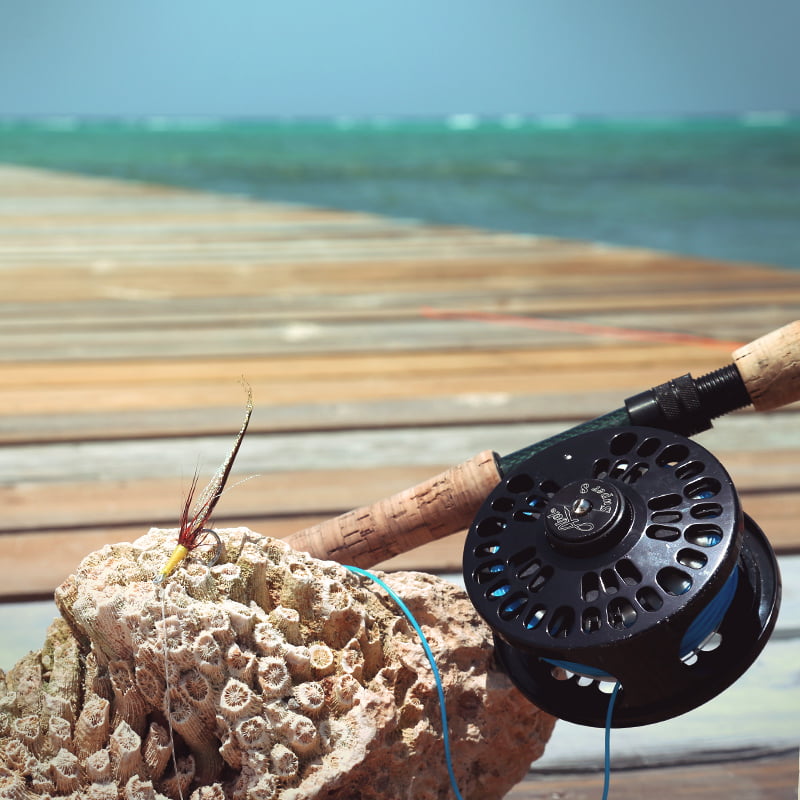Bonefishing Tackle & Gear
Cayman Fly Fishing Tackle
Rod: 7-9 Weight, Medium-Action, Saltwater
You’ve probably heard that fast-action rods are best for saltwater. Trust us, that’s not always true. In fact, a softer, more sensitive rod will load easier and allow you to be more accurate in close, which is where most bonefish are caught. After guiding for over a decade I can say that the vast majority of bonefish are hooked within 40 feet of the angler. At that distance a fast-action rod is barely loaded yet. So, when you’re at the flyshop test-casting that new rod, see how easy it is to load and hit targets inside 40 feet (3 rod-lengths from the rod-tip).
Reel: 7-9 weight, Large-Arbor, Anodized
Reels should have smooth, dependable drags and a minimum of 150 yards of 20-pound backing. Large arbors let you pick up line fast when a big fish turns and runs back at you. This is important. Bonefish only have two moves: they run away from you as fast as possible and then they run back at you the same way. If you can’t keep the line tight (which is why reeling with your dominant hand is sooooo important, but I’ll save that discussion for another time) then the fish can put slack in the line and slip the hook. Why anodized? Because saltwater eats metal. Trust us.
Line: 7-9 Weight-Forward Floating
Yes, full floating. Don’t get caught up in all that clear-tip, intermediate rubbish. Bonefish almost never swim in a straight line. They zig-zag down the flats; it’s what bonefish do. So, you need to be able to quickly and quietly pickup at re-cast. An intermediate tip makes that nearly impossible without first stripping back in a ton of line. By that time it’s game over. Oh, and let’s keep those lines visible. Clear lines suck for bonefishing, because if you don’t know where the end of your line is you don’t know where your fly is. Finally, make it a tropical fly line. These lines cast easier and farther in the heat and wind.
Leaders: 9-12 Ft, 12-16 Lb mono
I sometimes tie my own leaders, but usually I prefer prepackaged, extruded tapered leaders: Orvis®, Umpqua® or Scientific Anglers™, all offer good pre-packaged Bonefish leaders. Carry an extra spool of tippet material, and when a leader gets too short from changing flies you can easily add a little more length of the right strength. The Blood knot and the Double Surgeons are both good knots for adding tippet. Note: Fluorocarbon is good for tippet only. It’s greater density causes it to sink and catch the bottom.
Whether you’re fishing from a skiff, walking the beach or wading the flats for bonefish, having the right fly fishing tackle is an important part of being successful. The best flats fishing often takes place in remote locations where gear is not easy to come by. Cayman Islands boast a host of amenities, but a fly shop is unfortunately not among them. That’s why we tie all our own flies and leaders; there’s just nowhere on-island to purchase them. So, unless you hire a guide you’ll need to bring all your own gear. If you have any specific questions about tackle, feel free to email us at webmail@fish-bones.com.
- Sunglasses (copper polarized)
- Hat
- Buff® or neck gator
- Flats Booties (or old sneakers)
- Socks (to keep sand from chafing your feet)
- Long Sleeved Shirt
- Lightweight Long Pants
- Sun Block!
- Rain Jacket
Recommended Flats Clothing
Sunglasses: Polarized, Copper/Brown Lenses
You don’t have to spend $200, but you get what you pay for. The more expensive models are lighter, easier to wear and last longer. I suggest glass lenses and if they’re polarchromic, even better. The glass holds up way better to the sun (which breaks down polycarbonates) and will resist scratches better. Polarchromic lenses—lenses that darken in brighter conditions—allow you to fish earlier and later in the day and still see through the water. So, buy a good pair and carry the cheapies as backup. Oh, and unless you’re color blind and it doesn’t matter, do not buy grey lenses.
Shoes: Zip-up Booties or Flats Sneakers
Wading shoes are a necessity for locations where the bottom is grassy or rocky. An encounter between bare feet and sharp coral, broken shells or spiny sea urchins can end a trip fast. Zip-up neoprene and rubber booties are the best but again, there are inexpensive options. By the way, no need to drop $100+ on name-brand flats booties; an old pair of tennis shoes work great, and you can just toss them after your trip. Either way, I recommend you wear socks with them—to keep sand from chafing your feet.
Shirt: Breathable, Light-weight, Long-sleeve
There are lots of options here. The button-up, classic yoked flats shirts are great, but all those holes let in sandflies if your somewhere they’re around and the wind is down (like fishing dawn or dusk around mangroves). I prefer the micro-fibre, pullover models that are fairly snug. This material is wicking, which means it works best when it’s touching your skin, helping evaporate your sweat and cool you down. Oh, and light colors: tan, pale blue, silver, even white. One, dark colors actually attract mosquitos. Two, you’ll feel like your roasting on a clear, calm day.
Pants: Light-weight, quick-dry, UPF
I prefer shorts, always have. However, I’m from the Caribbean, and I’ve been wading my whole life. If this doesn’t describe you then I recommend long pants. So far my absolute favorites have been from Howlerbros and they’re made of some kind of ripstop nylon that is lightweight, breathable, UPF and dries faster than anything else I’ve worn. Well worth the money.
Buff: Coolmax™, UV
Technically called a neck gaiter, this is an indispensable piece of my flats-fishing outfit now. It protects my neck all day, and I pull it up when the sun rises. It helps project the delicate skin on your nose, ears, cheeks and lips after you’ve sweat all that sunblock off. Plus, it keeps bugs from biting you without having to douse yourself in poison.
Hat: Dark under-bill
Do NOT forget this. A sunburned forehead is the worst, and a hat makes your sunglasses work better, shading your eyes from distracting reflections, especially at midday, especially if it has a dark color on the underside of the brim. I like the mesh-backed trucker-style hats—they’re cooler—but the sun does get through them. I’ve seen folks get the top of their heads burned wearing these. No bueno. Same goes for visors, but more so.
Other Gear
Rain Jacket: Light-weight, Breathable
We all hope the sun shines all day, every day on vacation, but pop-up showers are common in the tropics, especially in summer. Plus, I’ve had some great days of fishing where it drizzled all day, and we caught fish! I recommend a lightweight, breathable material, like Gortex®. The old, nylon models make you feel like you’re being shrink-wrapped. As for color, that’s a personal choice. I’m mostly a wade-fisherman, so not too worried about being lost at sea and needing a bright color to get spotted from the search plane. My priority is stealth, so I prefer a neutral color like grey.
Pack: Wearable, Plastic Zippers
Now, I prefer a hip pack. Mine can be worn on my waist or (often) slung over my shoulders. It’s not waterproof, but I sometimes wish it was. (I wonder what’s cheaper: a waterproof pack, or waterproof phone case.) Waterproof or not, make sure it has pouches for water bottle(s). You never know when you’ll be wading far from the skiff/car/cooler. Hydration is critical in the tropics, especially if you’re not used to the sun down here. And, make sure it’s big enough to carry all that stuff mentioned above—tippet, leaders, fly-boxes, nippers, rain jacket, etc. (See what all I carry in my pack here. )
Socks: Crew, White
Ok, these seem strange to bring to the Caribbean, but trust me. First, they’re essential with wading booties to keep the sand from chafing and blistering your feet. Second, if you’re on a skiff you can wear them to keep the sun from frying the tops of your feet (which is why white socks). Finally they keep sandflies, mosquitos and doctor flies from biting you. I remember my first trip to Andros where the guide pulled on a pair of sock first thing that morning. No, we weren’t going wading, it was just doctor-fly season. I spent the rest of the day hopping around on the bow of the skiff trying to avoid being bit. Next day I wore socks!
Camera: Digital, Phone, Film, Etc
If this is your first bonefishing trip, you’re going to want a camera—which is easy now that we all have mobile phones. But, if you’re scared of drowning your iPhone®, I suggest an inexpensive water-proof pouch w/ camera port. Or, if you’re ol’-school, grab one of those disposable waterproof digital cameras. They work and then you can leave you phone back at the hotel, turned off… which is how it should be on a fishing trip.
Don’t Want to Travel with tackle?
We’ve got you covered!
Our rates include:
- Combat proven Rods, Reels, Leaders, Tippet & Flies.
- Transportation.
- Ice-filled Cooler with a few Light Refreshments.
- Flies for the Day’s Fishing
Come fly fishing with us and discover why Fish Bones Fly Fishing is fast becoming a guide service that stands for quality service to saltwater anglers worldwide.
Related Content
FISH BONES, Guided Fly Fishing is a private guide service located on the island of Grand Cayman. We specialize in wading fly fishing for bonefish and tarpon, with over 15 years of experience guiding and teaching anglers to fly fish the flats. Catch-and-release, sustainable sport-fishing. 100% Local!


